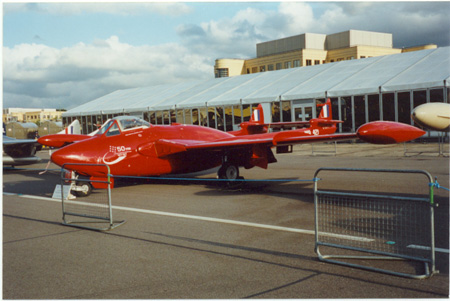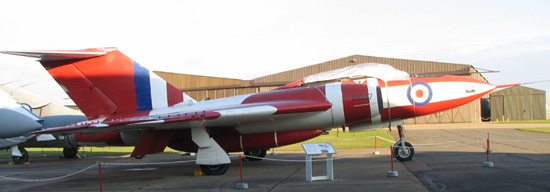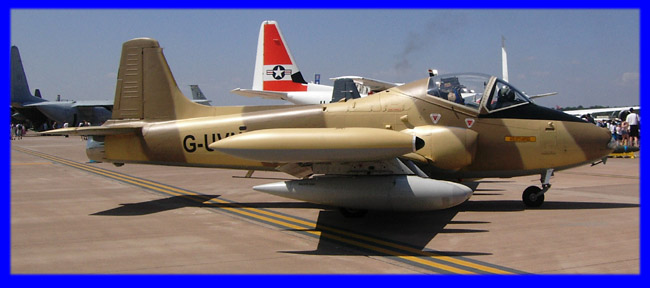|
| |
Back to Fighters
 |
The Gloster Meteor was the only British jet
fighter to see service in the second world war. It first flew in
March 1943. The Rolls-Royce Derwent jet engines were then very new,
so two were used for safety. With a speed of 490mph, they were the
only aircraft capable of catching and dealing with the V.1 unmanned
flying bomb. All told, almost 4,000 Meteors were built, and served
with ten air forces. This one is a T.7
two seat trainer, and was at Farnborough in September 1998. |
 |
The Armstrong Whitworth Seahawk was Britain's
first jet fighter to be operated from aircraft carriers. It was
designed by Hawker, but predominantly built by the Armstrong
Whitworth company. Its top speed was 480mph. It was operated by the
Royal Navy until 1966, but the Indian navy continued to use them
until 1984. Its single Rolls-Royce Nene engine had split exhausts on
either side of the wing trailing edge. 500 were built in total. They
also served with the Dutch and German navies.
This one was kept flying for a while by the Fleet
Air Arm Historic Flight (date & place unrecorded) |

 |
The De Havilland DH112 Venom was a
development of the earlier DH100 Vampire, which was De Havilland's
first jet aircraft, which entered service just too late to take part
in the second world war. The Venom first flew in September 1949.
1,400 were built, plus 120 under license in France as the Aquilon.
The single Rolls-Royce Ghost engine was mounted centrally, with the
twin-boom layout allowing the jet-pipe for the exhaust to be as
short as possible for maximum power. Top speed was 640mph.
Top picture: a former Swiss air force Venom was at Cranfield in July 1984.
Lower picture: Venom FB4 at Farnborough in
September 1998. |
|
|
The Hawker Hunter was Britain's most
successful post-war fighter, as well as being one of the most
aesthetically pleasing jets ever produced. It first flew in July
1951, and was the first British aircraft capable of exceeding the
speed of sound in level flight; top speed was 715mph. 1,900 of all
versions were produced. They were operated by air forces worldwide.
They were still in RAF service into the 1980s.
The top one is an FGA9, which was at Greenham Common in June 1979.
The lower picture is a Hunter T7, pictures at Fairford in July 2005. |
 |
the Gloster Javelin was an all-weather
interceptor fighter which first flew in November 1951. It is a big
(56 feet long, 52 feet wing span) heavy (35,690lb) delta winged twin
engined jet, powered by two Bristol Sapphire engines. Despite its
aggressive appearance, it was not quite capable of supersonic
flight. Just over 430 were built, all for the RAF. They had a short
service life before being replaced by the Lightning.
This picture is a Javelin FAW9, at Duxford in
December 2005. |
|
|
The English Electric Lightning is a deceptive
aircraft. From the side it looks fat and sluggish, but from
underneath its aggressive fighter lines are clearly apparent. In its
day it was one of the most potent fighters in the world, rivalling
the best the US and Soviet air forces could produce. It was designed
by the English Electric company in Preston, Lancashire (same
designer as the Canberra jet bomber). 340 were built. It was powered
by two Rolls-Royce Avon turbojets, which gave it a top speed of
twice the speed of sound. Most impressively (to anyone standing near
it) was its rate of climb of 50,000 feet per MINUTE! Standing almost
vertically on its tail, it would be out of sight very quickly - but
not out of sound; it was VERY loud. first flight was in August 1954.
Lightnings were responsible for interception of
any suspicious aircraft venturing into British airspace until the
1980s, when they were replaced by the Tornado.
These photographs show a Lightning mark 3
flying at Yeovilton in July 1986. |
|
|
The De Havilland DH110 Sea Vixen was the
ultimate development in De Havilland's twin-boom fighter series.
Designed from the start for operation by the Navy from aircraft
carriers, it features an unusual offset cockpit (on the left of the
fuselage only). 150 were built. It was powered by two Rolls-Royce
Avon turbojets, giving it a top speed of 645mph.It first flew in
September 1951. It is often remembered for a sad reason - the very
public disintegration in mid-air of an early prototype at a
Farnborough air show in the early 1950s.
It was technically superseded by the Phantom and
withdrawn from service in the 1970s. T
The top picture shows a Sea Vixen still in use as
a development test aircraft, at Greenham Common in June 1979. The
lower picture shows a preserved Sea Vixen at Duxford in December
2005; its size can be judged from Charles (aged three) standing
beside it. |
 |
The BAC TSR2 is one of the most shocking
stories of incompetence in post-war Britain, and a grotesque symbol
of British decline. Originally conceived as a multi-role combat
aircraft to replace the Canberra, its future was put in doubt from
the start when defence minister Duncan Sandys announced that the
days of manned aircraft were over. Bureaucratic muddle led to the
specification constantly changing. The Government, concerned
(actually quite reasonably) that there were too many British
aircraft companies, only accepted bids from companies who were
prepared to merge: British aircraft Corporation (BAC) was created
from Bristol, Vickers, English Electric and Gloster, and Hawker
Siddeley from Hawker, De Havilland and Avro. BAC won the bid, but
had not restructured so was itself a bloated bureaucracy. Delays
grew and costs spiralled. Poor communication led to design faults.
But one by one the problems were overcome, and despite the price per
TSR2 being `as much as a pre-war destroyer' and `ten times the cost
of a Buccaneer', the result was a highly capable aircraft. But only
one ever flew. The project was cancelled by the Labour minister
Denis Healey in 1965, thus ending the last all- British jet fighter
except one. Instead, the RAF ordered the American F-111, but
delays and cost increases in this led to the RAF order being
cancelled at yet more wasteful cost. Ultimately, the F-4 Phantom was
procured instead - a far less capable aircraft, and nothing to show
for all the costs incurred in bringing the world class TSR2 almost
to fruition. Two TSR2s survive. This one
is in the museum at Duxford. |
 |
The British Aerospace (formerly Hawker
Siddeley) Harrier was the only serious military aircraft programme
to escape the catastrophic cuts of the Labour government in 1965. It
was an ambitious project to build the world's first practical
vertical take-off & landing (VTOL) jet aircraft. Huge technical
challenges were overcome by tremendous imagination and dedicated
perseverance. The biggest challenge was the engine; Rolls-Royce
delivered the goods with the Pegasus, an immensely powerful jet core
with outlets at the fan and the jet exhaust which could be directed
to four vectoring nozzles on the aircraft's sides. This let the
aircraft ride on four columns of air, giving the best practicable
stability in the hover. After years of testing the Harrier was
finally a success, and for many years was the only VTOL jet in
service (until the Russians produced the Yak 36 `Forger'). Today, it
is the only practical VTOL jet in service, and will be until the
USAF's new advanced tactical fighter enters service later this
decade. Many have been built under license in the USA by McDonnell
Douglas. Harriers have served with the
Royal Air Force, US Marines, and the Indian and Spanish forces. This
picture is of an AV-8A Harrier operated by the US Marine Corps, seen
at Farnborough in September 1976. |
|
|
The British Aerospace Sea Harrier is a
development of the Harrier for use by the Royal Navy. It has the
same flying characteristics as the Harrier, but incorporates
modifications to facilitate operation from aircraft carriers. A new
fleet of small aircraft carriers were ordered for the Royal
Navy with a `ski jump' front end to facilitate launching Harriers
with maximum payload. most noticeable differences from the normal
Harrier are the shape of the nose (to accommodate a more accurate
radar) and the shape of the cockpit, subsequently adopted by the GR5
and AV8B versions for the Air Force.
These pictures were taken at Yeovilton in August 1980. The lower
picture is of a Harrier hovering: it isn't actually landing on the
wing of the B-17! |
 |
The British Aerospace Strikemaster was a
heavily armed ground attack aircraft developed from the Jet Provost
trainer. Powered by a single Bristol Viper engine of 3,410lb thrust,
it had a top speed of 420mph and could carry 3,000lb in mixed stores
on its underwing hardpoints. It first flew in October 1967. Although
a somewhat dated concept, a respectable 146 were built for several
air forces. Oddly, the British never used it.
This one was at Fairford, July 2005 |
 |
The BAe EAP was an Experimental Aircraft
programme to develop technology for the
Eurofighter Typhoon. Its two 9,000lb Turbo Union RB199 engines
give it a speed in excess of Mach 2. A fairly large machine (48 feet
3 inches long, 38 feet 7 inches wing span) and a heavy one (gross
weight 32,000lb), it was nevertheless an agile performer. It first
flew in August 1986. Only this one was built.
It was seen at
Farnborough, September 1986 |





|